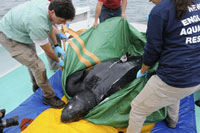Male Dermochelys coriacea was underweight and lethargic.
Click image to enlarge Leatherback sea turtle about to be released. Photo by New England Aquarium |
A male leatherback sea turtle (Dermochelys coriacea) weighing 655 pounds was released back into the ocean off Cape Cod after two days of treatment for dehydration and shock at the New England Aquarium. The turtle, measuring 7 feet in length was found stranded last week and was underweight and lethargic, according to the Boston Globe. The turtle was brought to the aquarium's Animal Care Center where it was given a sugar solution, vitamin supplements, steroids and antibiotics in an effort to mitigate any infection. The chelonian's right flipper was also damaged.
A decision was made to release the turtle due to very limited success with leatherback rehabilitation at the aquarium. The aquarium's rescue director Connie Merigo, said leatherback's can't grasp the concept of barriers and would hit the wall of its enclosure, causing further damage to the turtle. This turtle was placed in a harness that enabled aquarium personnel to turn him away from walls as he approached them. A tracking device was placed on the turtle's shell that will enable it to be tracked via satellite. The scientists were unsure why the turtle had come ashore and are unsure whether the turtle will survive. "The choices were really to euthanize him, keep him in rehabilitation, or release him,” head veterinarian Dr. Charles Innis told the Globe. “He was too strong to euthanize, and too strong to keep. . . We elected to release him, but with a little discomfort.”
Leatherback sea turtles are the largest sea turtles and can grow to 1,000 pounds. They do not have a hard carapace like other sea turtles but rather have a leathery skin. They have been recorded diving to more than 3,900 feet and feed primarily on jellyfish. They can also tolerate colder waters than other sea turtles.



